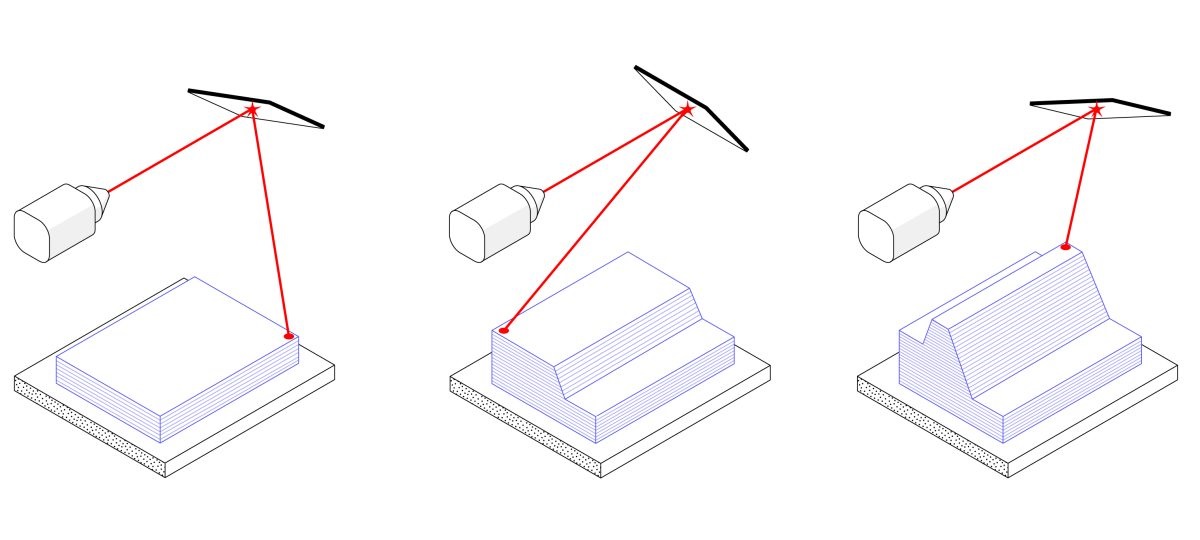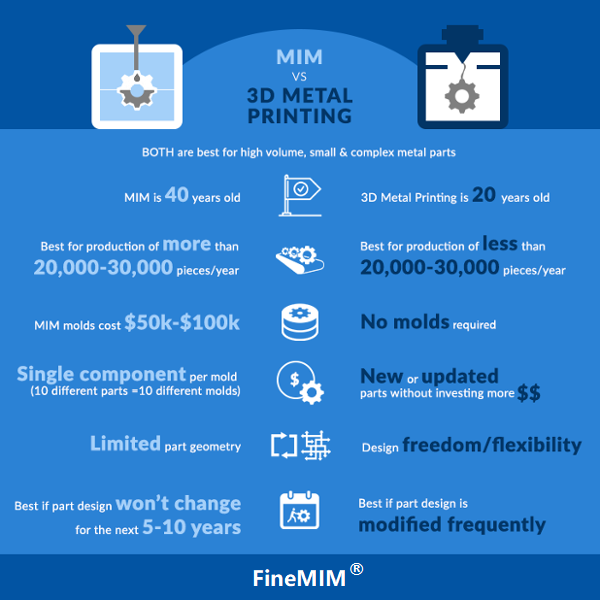Both metal injection molding (MIM) and metal 3D printing technologies have seen increasing levels of technical development recently, and metal 3D printing is becoming a great complement to metal injection molding.
Manufacturers today who are searching for a cost-effective way to make small and complex metal parts for production by and large only have two options: metal injection molding (MIM) or investment casting. Casting has been around for thousands of years, and MIM was created ~40 years ago. Metal 3D printing is the new entrant to the scene, and for the first time in a long while adds another option to the engineer’s toolkit. New low-cost, high volume metal 3D printing technologies are beginning to change conventional manufacturing wisdom.
Metal Injection Molding (MIM)
Today Metal Injection Molding has matured into a core manufacturing technology and is widely used in the production of small components for a variety industries and a large number of material options. This was not always the case — when MIM first came onto the manufacturing scene over 30 years ago, it suffered setbacks due to lack of process understanding and new entrants flooding onto the scene. Part repeatability, voids, and fatigue issues plagued many MIM providers and the poor part performance soured the reputation for many manufacturing engineers. It was seen as a manufacturing technology of last resort, only to be considered when all other avenues of production had been exhausted or when cutting costs was prioritized over part performance.
MIM has come a long way since the early days, and today’s best MIM operations have proven that MIM is capable of reliable high-volume production and strong material properties.
MIM is used to create components in numerous markets including medical, firearms, general industrial, and many others. When a part design is not likely to change for the next 5 to 10 years because it is part of a long design-in cycle and the volumes will be in the hundreds of thousands to millions, then investing in MIM tooling can make a lot of sense from an economic perspective. One of the main headaches for manufacturing engineers when using MIM is having to write the check for the mold (which can cost as much as $7K – $15K/Set). If you know the cost of the mold will be quickly amortized over millions of parts, then the investment could make a lot of sense.
Metal 3D Printing (Additive Manufacturing)
Metal 3D printed parts made by applying thin sheets or threads of material, layer after layer, play a valuable role in developing a product that has the potential to shift to injection molding.

Printed parts can act as prototypes before final design or be used to assess the initial form, fit, and sometimes functionality of parts within a product. Should the part be needed in greater quantities in the future, a company can then ramp up to injection molding.
Though 3D printing and injection molding share some similarities in plastic and metal materials and the process of designing a 3D CAD model, they differ in some crucial ways. Designers and engineers will need to keep a few things in mind as they move from one to the other. Prototyping small precision parts intended for volume powder metal production processes such as Metal Injection Molding (MIM) or Pressed Metal (PM) is difficult. Developing tooling and qualifying production methods can be a long iterative process. Metal 3D printing solutions provide more competitive options than traditional tooling resulting in accelerated part development. Users can much more easily build metal parts for evaluation, functional testing, and production use. It’s also exciting how many materials will be made available. Metal of 3D printing is planning for a variety of options, from steels and aluminum to superalloys and titanium.
Additive manufacturing allows for the rapid prototyping and physical testing of a design, so designers can iterate quickly and reduce their products’ time to market. Whether they need a small, thin-walled part, one with complex geometries, or a large, durable prototype or bridge part, they can have a 3D-printed part, or set of parts, made quickly to avoid the initial tooling expense of prototyping a limited amount of injection-molded parts.
When to Use Metal 3D Printing vs. Metal Injection Molding
Bind & sinter technologies are dramatically driving down the price-per-part for metal additive manufacturing, but how do they compare to MIM? The best bind & sinter technologies today are a great option when volumes are well above prototyping but below the break-even cost of investing in the MIM tool. This decision partially depends on the cost of the mold and is usually when production volumes head north of 20,000 to 30,000 pieces per year. At volumes just below that, it is often more cost effective to have your parts manufactured with a low-cost bind & sinter technology.
It’s important to remember the freedom offered by metal additive manufacturing with regard to design flexibility. In addition to being able to create geometries not possible with MIM, updating a design is trivial with metal 3D printing as compared to buying a new mold every time a change is needed. Molds also need maintenance after high production volumes and eventually will require repairs or replacement.
Manufacturers working on their new products and researching the most cost-effective way to manufacture small and complex parts need to be investigating bind & sinter technologies. The cost analysis can be done quickly to determine whether MIM is the best option or whether metal additive manufacturing is the most cost-effective path forward.

